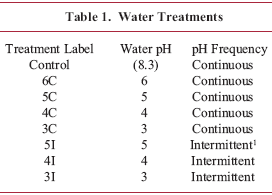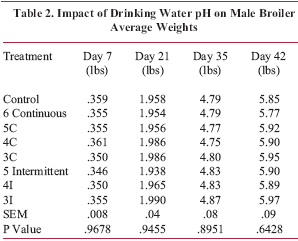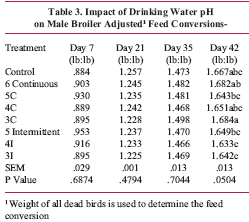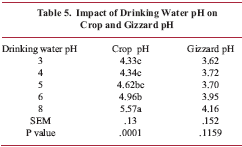



Effects of Water Acidification on Broiler Performance
By Susan Watkins, Jana Cornelison, Cheyanne Tillery, Melony Wilson and Robert Hubbard at the University of Arkansas's Avian Advice - Acidifiers such as sodium bisulfate, citric acid or vinegar are often used by poultry producers to lower the pH of the drinking water they give their birds. Many claim that adding these products results in an increase in water consumption, less feed passage or firmer droppings from the birds.Introduction
| The Author | |
 Dr. Susan Watkins Extension Poultry Specialist |
|
While the manufacturers of these products provide mixing instructions, there is no guarantee of the
final water pH mainly because of the broad diversity of water pH found in nature. A report from
North Carolina State University several years ago claimed that a water pH of less than 5.9 was
harmful to bird performance (Carter, 1987).
However this report was based on field observations
where unknown factors other than naturally low water pH could have contributed to the poor
performance. Low pH water is aggressive and can actually dissolve metal pipes releasing lead,
copper and other minerals into the water. While the use of PVC pipes minimizes the concern of
mineral leaching, the question still remains. Which water pH level is optimum for broiler performance?
Therefore, two trials were conducted to study the impact of different water pHs on broiler
weight gains, feed conversion, water consumption and livability. In addition, this experiment
addressed adjusting the water pH on a continuous or intermittent basis to determine if this could also
have an impact on performance.
Trial One
 Trial one was conducted during the summer months when
the outside daily temperatures exceeded 90° F, particularly
late in the grow-out cycle. The effects of heat stress were
reduced through the utilization of tunnel ventilation and spray
on fogger pads.
Trial one was conducted during the summer months when
the outside daily temperatures exceeded 90° F, particularly
late in the grow-out cycle. The effects of heat stress were
reduced through the utilization of tunnel ventilation and spray
on fogger pads.
Twelve hundred male broiler chicks were randomly placed
into 24 floor pens to give 50 birds per pen at a density of .85
square feed per bird. There were three pens per treatment.
Each pen was equipped with two hanging tube feeders and one
Val nipple drinker line complete with regulator and six nipple
drinkers. Flow was adjusted weekly to provide the milliliters/
week of age recommended by Lott et al. (2003).
The formula
for determining rates added 7 ml/week of age plus 20 ml, so
that, for example, a 21 day old broiler received 3 x 7=21 ml
plus 20 for a total of 41 ml. Each pen had its own water supply
via a 5- gallon poly-bucket reservoir. Table 1 denotes the
treatments. PWT®, which is sodium bisulfate, was used to
adjust the pH. Fayetteville, Arkansas municipal drinking
water was used as the control and the average initial pH was
8.3. All water and feed added to the pens was weighed. Birds
received diets formulated to meet their nutrient requirements.
In Trial one, Coban® was used for coccidiosis control. Also
the growth promoter BMD was used in all the feeds.
Trial Two
 Trial two was conducted during January and February
when outside daily temperatures ranged from 10 to 45° F. In
this trial, two thousand male broiler chicks were randomly
placed in 40 floor pens to give five pens per treatment. Four
replicate pens per treatment were equipped with nipple drinker
lines and the water added to these pens was measured for the
determination of water usage.
Trial two was conducted during January and February
when outside daily temperatures ranged from 10 to 45° F. In
this trial, two thousand male broiler chicks were randomly
placed in 40 floor pens to give five pens per treatment. Four
replicate pens per treatment were equipped with nipple drinker
lines and the water added to these pens was measured for the
determination of water usage.
A fifth replicate pen per
treatment was equipped with a Plasson drinker. Water
consumption was not measured in the pens with the Plasson
drinkers. As in trial one each pen had its own water supply
via a 5-gallon poly bucket reservoir and two hanging tube
feeders.
Treatments were identical to trial one with PWT®
used to adjust the pH. All feed added to the pens was weighed
for determining feed conversion. Birds received the same
diets as in trial one. In this trial, the coccidiostat Sacox® was
used. No growth promoting antibiotic products were used.
At day forty-two, 10 birds per treatment were killed
with carbon dioxide gas and the pH of the crop and gizzard
contents was determined.
Both Trials
In both trials the birds were group weighed by pen at day 1 and on days 7, 21, 35 and 42. On day 42 birds were individually weighed. Feed and water consumption were determined for each of these time periods. Water usage was measured at each feed change.
Results
 The results for the two trials were combined because
there were no differences in the way birds responded to the
treatments for the two trials. The average weights of the
broilers for the different ages evaluated are shown in Table 2.
The results for the two trials were combined because
there were no differences in the way birds responded to the
treatments for the two trials. The average weights of the
broilers for the different ages evaluated are shown in Table 2.
The statistical analysis indicates that while there may be slight
numerical differences in the average weights of the broilers
receiving the different treatments, there was no advantage or
disadvantage for the broilers receiving different pH drinking
water as compared to birds receiving the control water. The
closer the P value is to one, the more statistically similar the
results.
Table 3 shows the average feed conversions (adjusted
to account for the weight of the dead birds). Cumulative feed
conversions for days 7, 21 and 35 were not statistically
different. The feed conversions at day 42 show birds on the
continuous 4 and 5 pH water and the intermittent 3 and 4 pH
water had the numerically best feed conversions. However,
the conversions were statistically similar to the conversions
for broilers receiving the control water. Water usage as shown
by milliliters of water used per gram of gain showed that the
birds used similar amounts of water regardless of drinking
water pH (Table 4).
When the crops and gizzards of birds
receiving the different pH water were tested for pH, it was
found that the birds receiving the pH 3, 4 and 5 water had a
significantly lower crop pH than birds receiving the 6 and
control pH water (Table 5). No difference was found in the
gizzard pH and this would be expected since the bird adds
hydrochloric acid to the digestion process.
Comments and Conclusions
 This research project found no significant improvement
in average weights, feed conversion or water consumption
when the drinking water pH was lowered to 3, 4 or 5. The
results indicate that birds are very tolerant of a wide range of
pH water. The findings that the crop pH was significantly
lowered by reducing the water pH might explain why producers
have reported that bird droppings become more firm when
acidifiers are added to the water. The crop serves as a storage
compartment for consumed particles.
This research project found no significant improvement
in average weights, feed conversion or water consumption
when the drinking water pH was lowered to 3, 4 or 5. The
results indicate that birds are very tolerant of a wide range of
pH water. The findings that the crop pH was significantly
lowered by reducing the water pH might explain why producers
have reported that bird droppings become more firm when
acidifiers are added to the water. The crop serves as a storage
compartment for consumed particles.
Nature designed the
crop to store whole bugs and seeds, not the finely ground,
easily digested feed utilized by broilers for efficient feed
conversions. If the crop is full of feed and poor quality water
is added, then there is an increased risk for the development of
harmful bacterial and mold that could impact the rest of the
digestive tract. However, research done in Alabama by
Hardin and Roney (no date) found that a pH range of 4 was
not favorable for bacteria such as E. coli, Salmonella and
Clostridium to grow and thrive.
 The current research indicates
that it is possible to decrease the drinking water pH to a
range that would lower the crop pH to almost 4, thus creating
an environment that is hostile for undesirable microbes.
However, given the diversity of drinking water sources it is a
very good idea to measure the pH of the drinking water when
using acidifiers at manufacturer’s recommendations because
the natural buffering capacity of water may result in reduced
impact of the acidifier on pH. It may even be necessary to add
more acidifier to the stock solution to achieve a lower
drinking water pH.
The current research indicates
that it is possible to decrease the drinking water pH to a
range that would lower the crop pH to almost 4, thus creating
an environment that is hostile for undesirable microbes.
However, given the diversity of drinking water sources it is a
very good idea to measure the pH of the drinking water when
using acidifiers at manufacturer’s recommendations because
the natural buffering capacity of water may result in reduced
impact of the acidifier on pH. It may even be necessary to add
more acidifier to the stock solution to achieve a lower
drinking water pH.
References
Carter, Thomas. 1987. Drinking Water Quality for
Poultry, Poultry Science and Technology Guide No. 42,
Extension Poultry Science, North Carolina University.
Hardin, Boyd and C.S. Roney. No Date. Effects of pH
on Selected Poultry Bacterial Pathogens, Alabama Department
of Agriculture and Industries State Diagnostic Lab.
Lott, B. D., W. A. Dozier, J. D. Simmons and W. B.
Roush. 2003. Water flow rates in commercial broiler houses.
Poultry Sci. 82 (Suppl. 1):102.

Source: Avian Advice - Winter 2004 - Volume 6, Number 2








